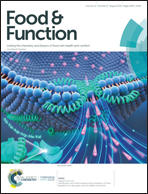Organic selenium derived from chelation of soybean peptide-selenium and its functional properties in vitro and in vivo†
Abstract
Organic selenium has been widely explored as an important source of selenium (Se) supplement due to its low toxicity and easy absorption. In the present study, a new type of organic selenium was fabricated by chelating Se with soybean protein isolate peptides (SPIPs), and its physio-chemical properties, structural characteristics, and antioxidant activities were investigated. Results indicated that the structure of the SPIP molecule was folded and aggregated during the chelation process. SPIP-Se exhibited stronger hydroxyl radical scavenging activity and reducing power than SPIP in vitro. In addition, SPIP-Se could repair the H2O2-induced oxidative damage of Caco-2 cells by enhancing the activities of antioxidant enzymes. The in vivo assay showed that SPIP-Se showed much less toxicity than inorganic Se supplements, and exhibited a more positive effect on the activities of key enzymes including superoxide dismutase (SOD), glutathione peroxidase (GSH-Px) and aspartate aminotransferase (AST). These findings suggest that SPIP-Se could be developed as an effective dietary Se supplement in the food or pharmaceutical field in the future.



 Please wait while we load your content...
Please wait while we load your content...